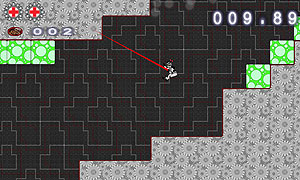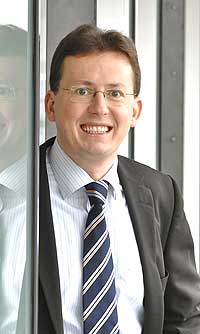Exactum rooftop greenhouse experiment grows herbs
A greenhouse has been built on the roof of Exactum in a collaboration by the Department of Computer Science and the Fifth Dimension science project. To begin with, sedum grass is growing on the roof and tomatoes, courgettes and chilli in the greenhouse. The greenhouse is 9.4 square metres large.
The motivation for the computer scientists is the estimation that 2% of the greenhouse gas emissions caused by humans are emitted by equipment using information technology. This is more than e.g. air traffic produces globally. To the scientists, this is reason enough to look into how to decrease the impact of information technology on global warming.

The facilities of the rooftop greenhouse were finished in 2011, and in the spring, the success of different utility plants has been tested. The scientists were driven by the idea that the greenhouse could be maintained with the excess heat from the servers.
Now, crops like tomatoes, rosemary, courgettes and various kinds of chilli are grown in Kumpula. A similar project is carried out in Paul Brenner’s Green Cloud super-computer project at the University of Notre Dame in Indiana, USA.
Scientists have been up on the Exactum roof before. Before the greenhouse was installed, they were testing the cold resistance of computers in tents in winter. Some of the same servers are still outside after surviving for three winters. So far, the only problems have been observed with one type of fan. The majority of the computers have been able to survive the long-term outdoor cooling perfectly well. The results are very encouraging, since the cooling of the data centres stands for 20-40% of their power consumption, sometimes even more in older data centres.
The greenhouse on the roof is surrounded by an experimental green belt. It is a part of the Fifth Dimension project and World Design Capital Helsinki 2012. The purpose of the green belt is to discover the best solution for roof gardens in Finland.
Professor Jussi Kangasharju and researcher Mikko Pervilä are the Computer Science Department members of the project Heating up the fifth dimension.
See how the plants grow and the research progresses >>
Text: Minna Meriläinen-Tenhu
Photo: Mikko Pervilä
Translation: Marina Kurtén

 Mika Urtela and Hannu Pajula, graduates of the Department of Computer Science, are realising their piña colada-flavoured dreams in their game-producing company, Soul Aim Studios. This is the beginning of their story. The piña colada part of it has not come true yet, but they're working at it.
Mika Urtela and Hannu Pajula, graduates of the Department of Computer Science, are realising their piña colada-flavoured dreams in their game-producing company, Soul Aim Studios. This is the beginning of their story. The piña colada part of it has not come true yet, but they're working at it. FiDiPro - the Finland Distinguished Professor Programme - enables distinguished international researchers to work and team up with the 'best of the best' in Finnish academic research. Financed by the Academy of Finland and Tekes, FiDiPro makes it possible to recruit highly merited scientists who are able to commit to long-term cooperation with a Finnish university or research institute.
FiDiPro - the Finland Distinguished Professor Programme - enables distinguished international researchers to work and team up with the 'best of the best' in Finnish academic research. Financed by the Academy of Finland and Tekes, FiDiPro makes it possible to recruit highly merited scientists who are able to commit to long-term cooperation with a Finnish university or research institute. The Faculty of Science invited Linus Torvalds to be its honorary alumnus in Kumpula. During its alumni event, the faculty also named one of its lecture halls after Linus Torvalds. On the event held on Thursday 17 March, young researchers were the main speakers, and the 350 guests on the science campus gave them their full attention.
The Faculty of Science invited Linus Torvalds to be its honorary alumnus in Kumpula. During its alumni event, the faculty also named one of its lecture halls after Linus Torvalds. On the event held on Thursday 17 March, young researchers were the main speakers, and the 350 guests on the science campus gave them their full attention.